Just in the nick of time and after a few months break, Passing of the Pioneers is back with ten obituaries for the month of November. Remember to click on any underlined text to take you to more information about a subject.
RUSSELL, George – Died 3 November 1888 at Shelford.

GEORGE RUSSELL 1852. Image courtesy of the State Library of Victoria http://handle.slv.vic.gov.au/10381/282507
George Russell was born on 12 June 1812 at Cluny, Fifeshire, Scotland. At the age of eighteen, he left Scotland for Hobart to meet up with his brother Phillip who had been in the colony for nine years. George spent several months at Dennistoun, the property of Captain Patrick Wood at Bowthell, Tasmania. The following year George leased land in the area and spent the next two years, improving and cultivating it, doing much of the work himself. By 1835, George was twenty-three and leasing a property at Lauriston when he heard the news of John Batman landing at Port Phillip and of the good land in the area. It was then he decided he must go and see for himself.
Soon after, Captain Wood sold a flock of sheep to men wanting to establish a sheep station at Port Phillip so George took up the opportunity to travel with the sheep. They left in March 1836 on the schooner Hettie, landing at what is now Brighton, Victoria. From there, George and the two station owners rowed up the Yarra River to what is now the city of Melbourne. They then walked around 200 miles over the next seven days following the Werribee River to the Barwon River and then to the Leigh River. As they made their way through the valley of the Leigh, George decided that was where he wanted to settle.
George returned to Tasmania for the winter of 1836 and made plans to return to the Leigh Valley. He sold his property and arranged for his sheep to be transported to Port Phillip. Around that time the Clyde Company had formed and George was chosen to manage it. The company’s first station was on the Moorabool River and George went there from the spring of 1836.

Advertising (1838, December 8). Port Phillip Gazette (Vic. : 1838 – 1845), p. 3. Retrieved November 16, 2019, from http://nla.gov.au/nla.news-article225006721
Two years later at the age of twenty-six, he built a hut in the Leigh Valley where he had visited two years before and close to what would be become the township of Shelford. The land on which the hut stood become the Golf Hill estate. In 1850, George travelled to England then on to his homeland of Scotland. While there, he married his cousin Euphemia Leslie Carstairs in 1852 and a daughter was born the following year. George and Euphemia returned to Victoria and in 1854, a daughter Ann was born at Geelong. A further five daughters and one son were born over the next eleven years until the birth on 24 April 1866, of a daughter Janet.
George had become a partner of the Clyde Company and in 1857, the company was dissolved and George was able to purchase the freehold for the Golf Hill property. In 1859, photographer Thomas Hannay toured the Western District and dropped in a Golf Hill and took this photo of the then brick homestead and the three eldest Russell daughters. The home was designed by Alexander Skene of Geelong in 1846.

GOLF HILL c1859. Photographer: Thomas Hannay. Image courtesy of the State Library of Victoria http://handle.slv.vic.gov.au/10381/321169
On 3 March 1867, Euphemia died leaving George with eight children including baby Janet. The month prior to Euphemia’s death, George had purchased the Punpundhal estate near Camperdown. Considering his loss, George renamed the property Leslie Manor in remembrance of her. In 1882, he purchased the Strathvean and Poliah estates near Cressy from Hugh McVean.
In 1876, the brick cottage in the previous photo was demolished to build the homestead below, designed in the French Second Empire style.

GOLF HILL, SHELFORD. Image courtesy of the State Library of Victoria http://handle.slv.vic.gov.au/10381/320773
George made a great contribution to the nearby Shelford community including covering the cost of the construction of the Presbyterian Church below.

SHELFORD PRESBYTERIAN CHURCH. Image courtesy of the State Library of Victoria http://handle.slv.vic.gov.au/10381/320782
George died in 1888 and was buried at Golf Hill. He left seven daughters and one son, Phillip. He inherited Golf Hill but Phillip’s youngest sister Janet, already having developed an interest in the property, who stepped in and took over the running of Golf Hill with Phillip’s blessing. Phillip died in 1898 but with no wife or heir, it was Janet who inherited Golf Hill.
You can read more about George Russell and Shelford on the link to the excellent blog, Barwon Blog: Anything and Everything to Do With the Barwon River http://barwonblogger.blogspot.com/2013/07/branching-out-life-at-leigh.html
DILNOT, George – Died 29 November 1892 at Hamilton. George Dilnot was born at Herne Bay, Kent around 1852. As a young man, he went to London to work as a commercial traveller. It was there he married Emily Wallis, a distant relative of Charles Dickens. Around 1882, the Dilnots arrived in Victoria and over the next two years, George held a range of jobs including working for James Henty and at Bruce’s Brewery at Sandhurst. In 1884, the family arrived in Hamilton as George had been appointed to take over the running of the Western City Brewery (below) which he later bought and then sold again soon after.

VIEW OF HAMILTON VICTORIA. (1888, April 17). Hamilton Spectator (Vic. : 1870 – 1918), p. 1 (SUPPLEMENT TO THE HAMILTON SPECTATOR). Retrieved November 16, 2019, from http://nla.gov.au/nla.news-article225809074
George then became an accountant with the Hamilton Spectator in 1887 and 1888 as well as taking on freelance work. He was then able to open his own accountancy and auctioneering firm.
George died suddenly in 1892 leaving his wife Emily and five children A large procession left his residence Marathon on the corner of Carmichael and Gray Streets for the Hamilton Cemetery where more mourners had gathered including members of the Masonic Lodge.
In February 1893, Emily and the children returned to England to live.
EDWARDS, Morris – Died 9 November 1904 at Casterton. Morris Edwards was born in England around 1832. In 1854. Richard Lewis of Rifle Downs near Casterton imported a three-year-old thoroughbred from England called King Alfred who would go on to become the colony’s leading sire. Morris Edwards accompanied the horse to Australia as its groom on the ship Severn. On the ship, Morris met a young lady Eleanor Anne Lamborn. They married in 1856.
Morris stayed at Rifle Downs for a number of years before working for John Robertson at Straun. In the early 1870s, Morris and Eleanor settled at Casterton. Around 1877, Morris took over the livery stables of Casterton’s Albion Hotel which he did for about three years before retiring.

Advertising (1877, October 9). Hamilton Spectator (Vic. : 1870 – 1918), p. 3. Retrieved November 16, 2019, from http://nla.gov.au/nla.news-article226043057
Morris and Eleanor lived on Toorak Hill at Casterton. Morris died in 1904 at the age of 72 while Eleanor died in 1914 at Casterton.
In 1931, the following article was published in the Sporting Globe about a rather grisly family heirloom in the possession of Morris’ son Morris Jr. It was an inkwell made from a hoof of King Alfred who died in 1873 at Koolomurt near Casterton.

MOMENTO OF KING ALFRED (1931, January 10). Sporting Globe (Melbourne, Vic. : 1922 – 1954), p. 2 (FIRST EDITION). Retrieved November 16, 2019, from http://nla.gov.au/nla.news-article183010196
In 1934, one of Morris and Eleanor’s daughters wrote a Letter to the Editor of The Age in search of passengers from the voyage of the Severn in 1854, the ship her parents, aunt, sister and of course the horse King Alfred arrived on.
RIPPON, George Reynolds – Died 2 November 1912 at Hamilton. George Rippon was born in Geelong on 27 May 1867, a son of George Reynolds Rippon and Maria Smith. In 1876, his father went into a partnership in the Hamilton Spectator newspaper, later becoming sole proprietor. The family moved from Geelong to Hamilton and George attended Hamilton College before going to work at the National Bank. He then obtained a job a the Melbourne Stock Exchange.
Eventually, George returned to Hamilton and went to work at the Hamilton Spectator as a journalist. His father died in 1899 and George’s brother Herbert took over the running of the Spectator. In 1900, gold was discovered at the foot of Mount William in the Grampians. It wasn’t long before the area was populated with those seeking their fortunes. George travelled to the Grampians to see the diggings for himself and decided to start a newspaper for the miners called The Mount William Pioneer. Printed at the Hamilton Spectator, the paper and it was very popular with twenty-three editions published between July and December 1900. The rush was short-lived and the newspaper folded.

WINTER ON THE MT WILLIAM DIGGINGS 1900 Image courtesy of the State Library of Victoria http://handle.slv.vic.gov.au/10381/172520

No title (1900, July 28). Weekly Times (Melbourne, Vic. : 1869 – 1954), p. 2. Retrieved November 27, 2019, from http://nla.gov.au/nla.news-article222249274
Like his father, George was a talented sportsman and was a particularly good cricketer, a notable all-rounder. While at Hamilton College, George could throw a cricket ball over 100 yards. He was also a good footballer and was captain of his team in Hamilton. He had an interest in horse racing and was a handicapper for the Hamilton Racing Club and several other clubs around the district. He was also one of the best runners in the area over 50 yards, was a champion amateur billiards player, played lawn bowls and was an excellent shot. He was au fait with the sport of boxing and refereed matches while he was on the Mount William diggings.
George was sick for most of 1912, having contracted a disease while in NSW. He succumbed on 2 November 1912. When the news of his death reached the citizens of Hamilton, flags around the town flew at half-mast. George never married and was buried in the Rippon family plot at the Hamilton (Old) Cemetery.
O’DONNELL, Annie – Died 20 November 1917 at Hamilton. Annie O’Donnell was born in Limerick, Ireland around 1840. She arrived in Victoria and on 1 February 1863, she married Adolphe Jean Baptiste Destree born at The Hague, Netherlands. Adolphe was a Hamilton jeweller and watchmaker who previously had a shop in Portland. He also served as a Magistrate. A son Adolphe was born at Hamilton in 1864, the first of a family of five sons and one daughter. In November 1868, Annie became Lady Mayoress of Hamilton when Aldophe was elected Mayor. On 11 February 1875, Annie gave birth to a son but exactly four months later on 11 June, Adolphe died aged forty. Annie continued the business but by September 1875 she had sold to Farroll & Sons Jewellery Importers.
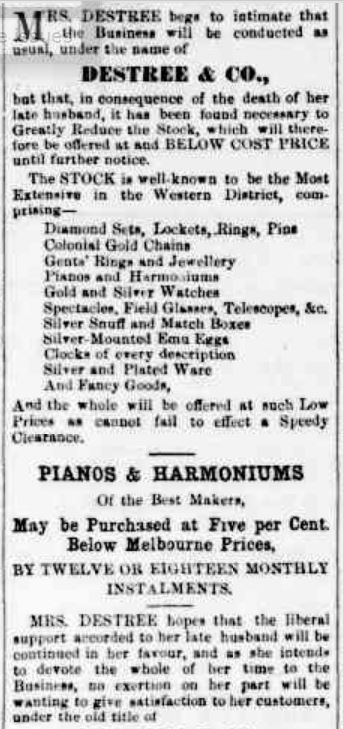
Advertising (1875, June 26). Hamilton Spectator (Vic. : 1870 – 1918), p. 2. Retrieved November 16, 2019, from http://nla.gov.au/nla.news-article226071758
Annie eventually moved from Kennedy Street to French Street close to the Hamilton Botanic Gardens. In 1898, the Hamilton Borough Council was one of several councils to receive a cannon from the decommissioned HMVS Nelson. It was placed near the main entrance of the gardens on the corner of French and Thompson Streets. In 1900, for Mafeking Day, the council thought it a good idea to fire the cannon. They tried it two years earlier and the result was broken windows to homes and businesses in the area. Of course, nothing was different in 1900 and many, including Annie, suffered broken windows and structural damage to their homes. Annie’s damage costs were £100 and she sought compensation from the council.
At the time of her death, Annie had four sons still living. She was buried at the Hamilton (Old) Cemetery.
RANKIN, John – Died 10 November 1936 at Colac.

JOHN RANKIN. (1923, August 3). Farmers’ Advocate, p. 3. http://nla.gov.au/nla.news-article223631678
John Rankin was born in the Mallee around 1865 and went to Colac with his family at a young age. When he was of working age he became involved in the local dairy industry and went on to become one of the leaders of the Australian Dairy industry. In 1892, John married Mary Jane Monkivitch. Aside from dairying, John was a non-commissioned officer with the Mounted Rifles and on the board of the Colac Waterworks Trust. Mary Jane died in 1932.
At the time of his death in 1936, John was chairman of directors of the Western District Co-operative Produce and Insurance Co Ltd, chairman of directors of the Colac Dairying Co Ltd, director of the Western and Murray Co-operative Bacon and Meat Packing Co Ltd, director of the Co-operative Insurance Company of Australia Ltd, a member of the executive council of the Victorian Dairymen’s Association, a member of the council of the Co-operative Butter and Cheese Factories Association of Victoria and a member of the Federal council of the Australian Dairy Cattle Research Association. Four sons and three daughters survived John. He was buried at the Colac Cemetery.
SAVIN, Mary – Died 29 November 1936 at Heywood. Mary Savin was born at Macarthur around 1867. Soon after, her parents William and Elizabeth settled at Muddy Creek, south of Hamilton. The family were involved with the local Primitive Methodist Church. Mary married John McIntrye in 1895 and they moved to Wallup in the Wimmera but later returned to the south-west, settling at Heywood.
During WW1, Mary and John’s second eldest son Murray enlisted. He was killed on 4 July 1918 at Amiens France while serving with the 23rd Battalion. In 1921, John McIntyre died and Mary continued on the farm with her sons. At the time of her death in 1936, Mary had eight children still living. She was buried at the Portland Cemetery.
On 24 June 1937, an article in the Portland Guardian reported on a send-off held for those members of the McIntyre family still living in the Heywood district who were off to Gippsland to live. “And so this respected family has left the Heywood district to the regret of everybody in that locality.”
VAUGHAN, Daniel – Died November 1944 at Swan Marsh. Daniel Vaughn was born at Ballangeich east of Woolsthorpe around 1872. As a young man, Daniel travelled around the country as a shearer before selecting land in the Otway district. In 1903, he married Mary O’Donnell and they went on to have a large family of eight sons and four daughters. Daniel was a supporter of the union movement, horse racing and in his early days, he was a good footballer. He was buried at the Colac Cemetery.
BOYD, James Alexander – Died 10 November 1944 at Camperdown. James Boyd was born at South Geelong around 1857. When he was about twelve, his parents went to live in Camperdown before settling at nearby Pomberneit. James married Mary Louisa Cooper in 1877 and they lived at Braeside Pomberneit.
James was a member of the Camperdown and Colac P&A societies. He was also an exhibitor at the local shows with his Lincoln sheep and in 1932, he revealed to the Camperdown Chronicle his collection of prize cards from the 1880s. He was also proved himself a thoughtful husband, having bought Mary a gold watch with his winnings.

CAMPERDOWN CHRONICLE. , OCTOBER 11, 1932. NEWS. (1932, October 11). Camperdown Chronicle (Vic. : 1877 – 1954), p. 2. Retrieved November 30, 2019, from http://nla.gov.au/nla.news-article23367240
James was a member of the Leura Lodge of Freemasons, the Pomberneit Rifle Club and in his early days, played cricket for Pomberneit
In 1937, James celebrated his eighth birthday. Later, he placed a Thank You notice in the Camperdown Chronicle

Family Notices (1937, June 22). Camperdown Chronicle (Vic. : 1877 – 1954), p. 7. Retrieved November 30, 2019, from http://nla.gov.au/nla.news-article26090561
James was a champion for the local children. He donated basketball trophies for local state schools to compete for in order to encourage the children to play. He also lobbied for a swimming pool at Camperdown for the ‘kiddies’.

LOOKING AROUND (1943, January 12). Camperdown Chronicle (Vic. : 1877 – 1954), p. 1. Retrieved November 30, 2019, from http://nla.gov.au/nla.news-article28322115
Mary died in July 1940 aged eighty-four. James died in the Camperdown Hospital in 1944 aged eighty-seven and was buried at the Camperdown cemetery.
WHAT A COINCIDENCE
While searching for further information on one of this month’s pioneers Annie Destree (nee O’Donnell), I found the following Birth notices from the Hamilton Spectator of 13 February 1875. As well as the Destree birth there was also the birth of a daughter to another of this month’s pioneers Morris Edwards and his wife Eleanor. Fancy that!

Family Notices (1875, February 13). Hamilton Spectator (Vic. : 1870 – 1918), p. 2. Retrieved November 26, 2019, from http://nla.gov.au/nla.news-article226076215





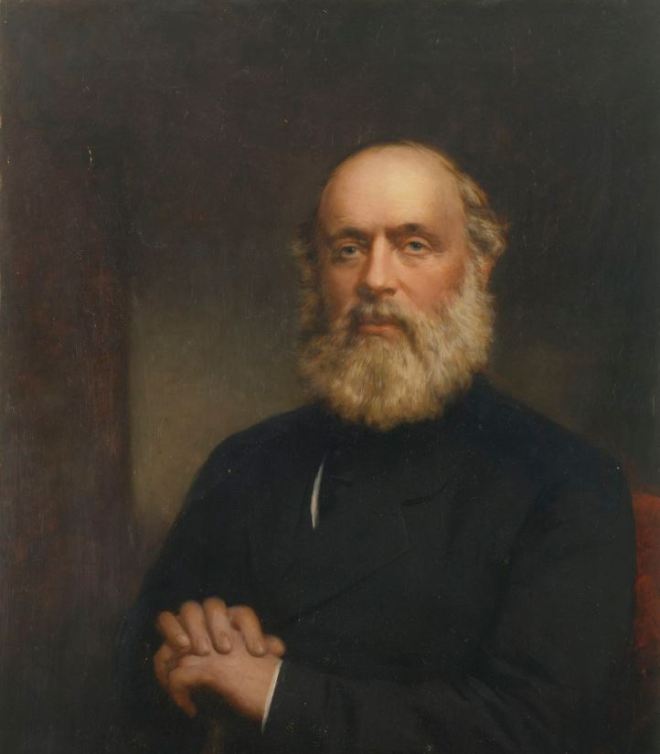





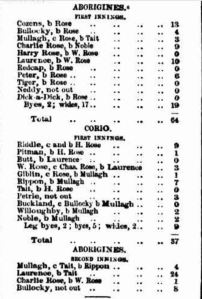










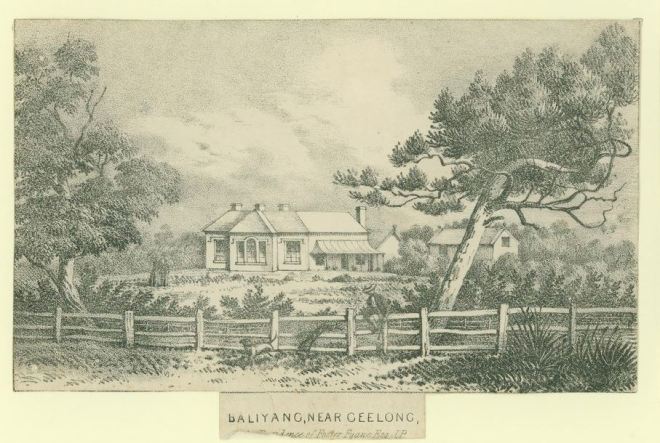




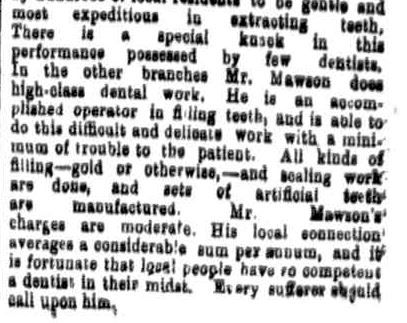

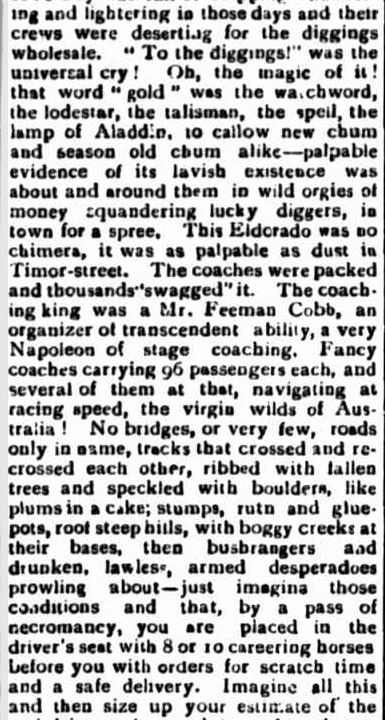


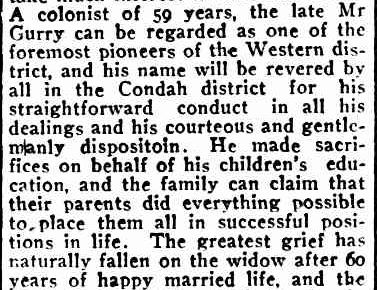




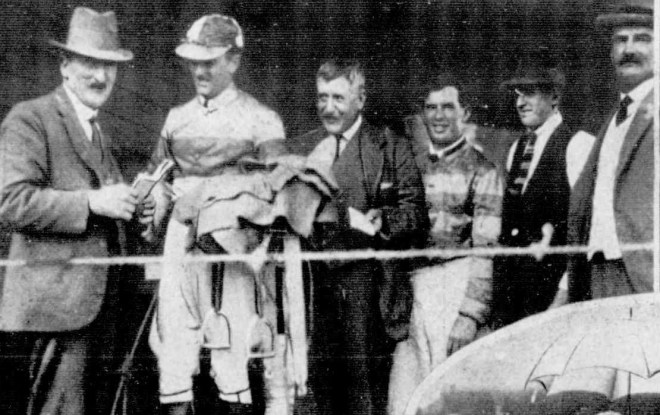

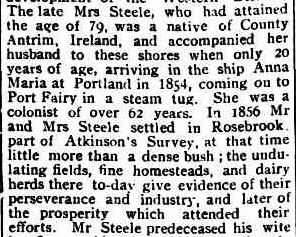




You must be logged in to post a comment.